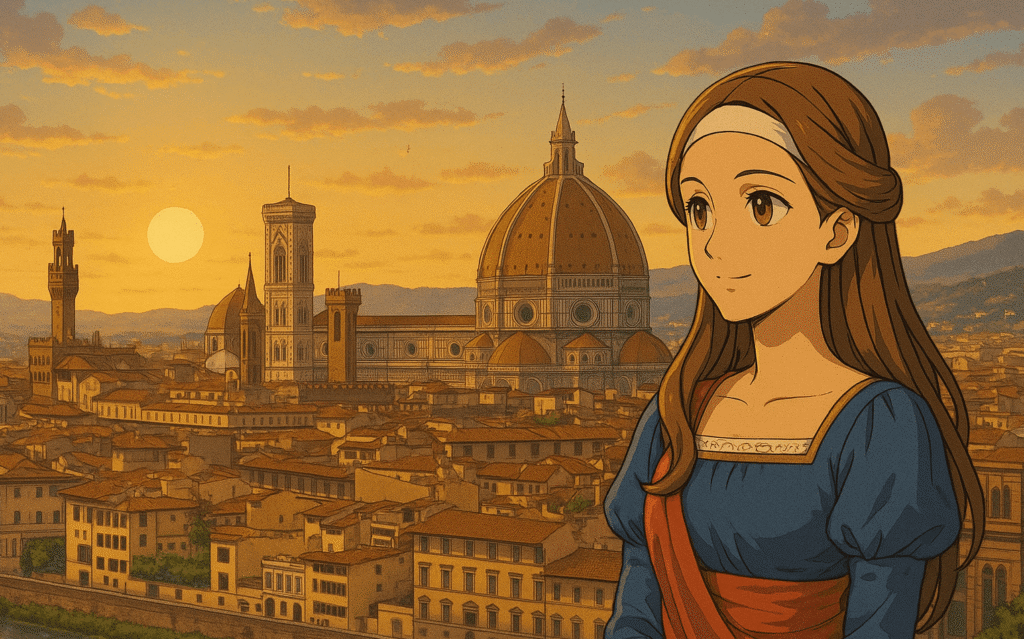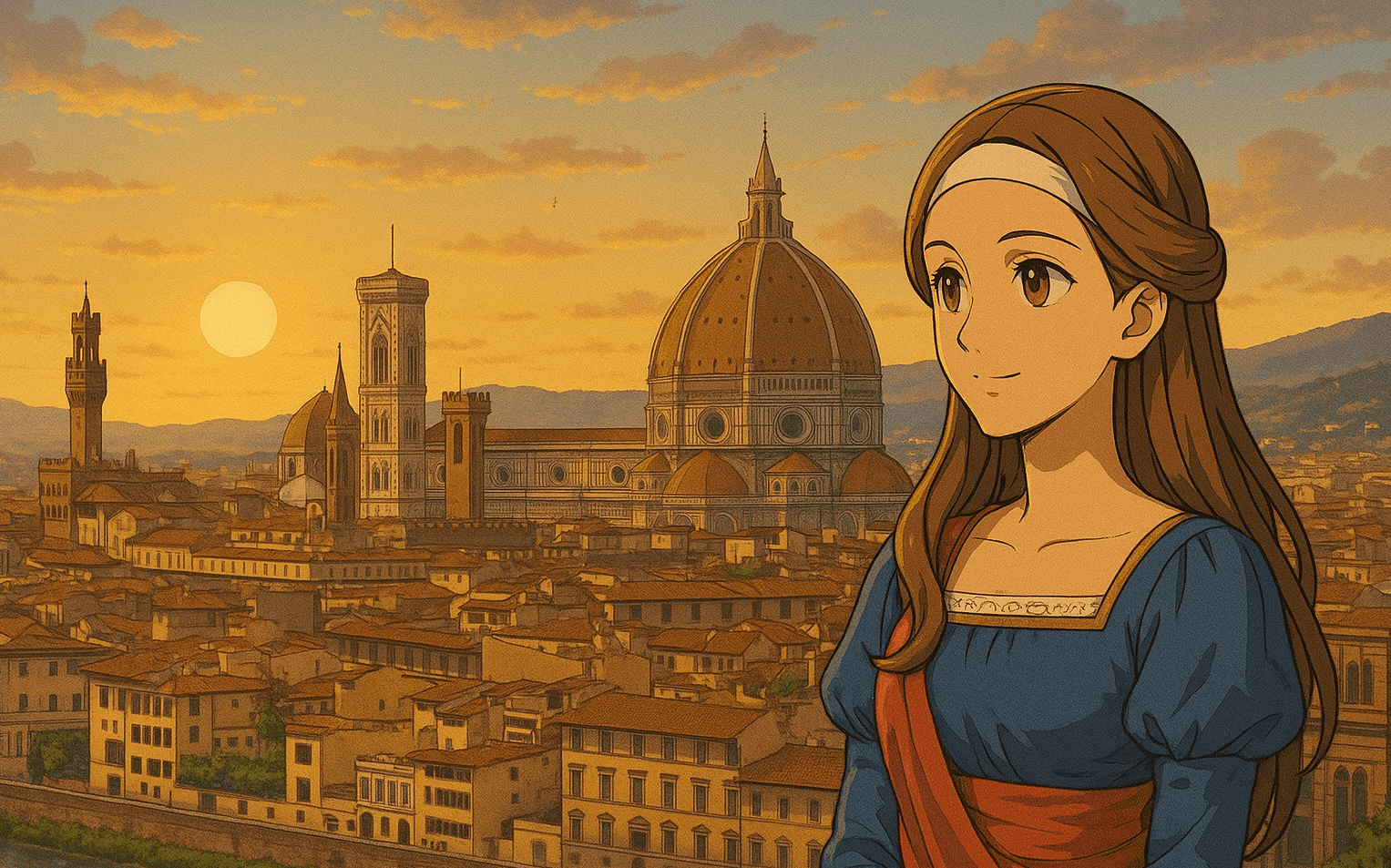The Renaissance – Innovation, Art, and Modern Impact

Where the Spark Ignited
Fourteenth‑century Italian towns found themselves at a crossroads. Maritime republics such as Venice handled spices and silk from Asia, while wool merchants in Florence sent bolts of cloth across Europe. War, plague, and shifting trade routes had drained older feudal courts of cash, yet coastal customs houses bustled with silver‑studded coffers. This liquid wealth let bankers extend credit to dukes, bishops, and shipping agents. A metalworker on the Arno now had a customer base wider than his parish.
Greek manuscripts fleeing Constantinople after 1453 met this commerce‑driven curiosity. Copyists hired by Florentine booksellers compared Aristotle with recent botany notes, finding gaps worth testing in gardens or workshops. The word umanista (humanist) emerged to label teachers who prized grammar, rhetoric, and history as tools for civic leadership. Rather than meditate only on salvation, these tutors asked pupils to weigh Roman legal cases or trace Cicero’s sentence rhythm. Clear prose became a badge of credibility in merchant letters and court petitions, foreshadowing today’s focus on concise email writing.
Brunelleschi, once registered with the goldsmiths’ guild, toured Rome measuring ancient domes. On return he submitted a wooden model for Santa Maria del Fiore in Florence. To lift fifty thousand tons of masonry without flying buttresses, he built a double shell and set bricks in a herringbone twist. The project office kept daily logs of rope length, hoist gear, and lime batches in Latin shorthand. Those ledgers read like modern engineering change orders, with signatures for every supply decision.
New Ways of Seeing and Knowing
Painting and sculpture reshaped perception
Giotto had already broken ground by giving halos a natural shadow, yet Masaccio’s fresco of the Trinity went further. Lines from the vanishing point draw viewers into an illusionary barrel vault. Linear perspective provided bankers a visual metaphor for balance sheets because depth could be mapped with numbers. Competition soon roared. Leonardo mixed oil, vinegar, and egg yolk to slow drying and layer transparent glazes. Michelangelo rejected bronze casting fees from the Signoria so he could carve marble that looked like living anatomy. Each creator relied on patrons who wanted civic pride expressed in stone and pigment. These commissions also served as marketing, drawing foreign envoys who later ordered similar pieces for courts in France, Poland, or England.
Printing multiplied ideas
Gutenberg’s metal movable type cut duplication costs by roughly ninety percent. By 1500, presses in Venice alone had issued over two million volumes. Entrepreneurs divided tasks into casting, typesetting, proofing, and binding, creating the first information factories. Aldus Manutius introduced italic fonts to squeeze more letters per page, saving paper expenses. That same thrift drives today’s UI designers to shave kilobytes off mobile apps.
Science crossed guild lines
Anatomist Andreas Vesalius dissected cadavers in Padua’s university theatre and published plates showing muscle origin points. Physicians across Europe tore outdated Galen volumes from their shelves. In Kraków and later Frombork, Nicolaus Copernicus compiled decades of star observations and proposed that Earth moved round the Sun. His tables simplified calendar reform and navigation maths, helping Portuguese pilots steer caravels far into the Atlantic. Galileo improved spyglass designs, spotted Jupiter’s moons, and argued that uniform motion hides inside natural fall. Each claim challenged inherited doctrine, forcing courts and bishops to weigh data against dogma. The resulting debates sharpened rules for evidence, now mirrored in peer‑review journals and courtroom expert testimony.
Finance and maths met parchment
Luca Pacioli, a friar who tutored mathematics, published a treatise that explained double‑entry bookkeeping. Debits on the left, credits on the right. Match them or search for missing florins. Merchants embraced the method because it flagged theft quickly and clarified risk on long voyages. The structure survives in cloud‑based ledgers where each debit triggers an equal credit event in code.
Patrons, Politics, and the Urban Race
Italian city‑states as incubators
Florence, Milan, Venice, and Rome behaved like rival start‑ups competing for talent. The Medici family bankrolled workshops in exchange for prestige, linking cultural output with diplomatic leverage. The Sforza court in Milan invited Leonardo to design canal locks and festival stagecraft alongside equestrian statues. Venice leaned on its arsenal, a shipyard complex capable of assembling a galley in a single day thanks to standardized parts and assembly lines that Henry Ford would echo centuries later.
Northern Europe adapts and expands
Outside the peninsula, Bruges merchants lured Hans Memling, while the Fugger bank in Augsburg floated loans to Holy Roman Emperors. Oil paints traveled north, meeting colder light and woolen textures; Jan van Eyck layered translucent reds on linen panels. Politically, Francis I of France opened royal budgets to import Italian architects, leading to châteaux such as Chambord, where Da Vinci spent his last seasons drafting a double‑helix staircase.
Religion and reform
Humanist reading habits stirred calls for spiritual renewal. Erasmus of Rotterdam edited a Greek New Testament, exposing copy errors. Martin Luther posted ninety‑five theses in 1517, challenging indulgence sales. Pamphlets flew across territories faster than bishops could confiscate them. While wars followed, the upheaval also birthed literacy drives so congregations could read scripture firsthand. Mass education grew from these lessons, feeding skilled clerks into growing bureaucracies.
Global outreach
Iberian crowns used updated naval tools to chart sea lanes. The Treaty of Tordesillas split new ocean routes between Portugal and Spain in 1494, but maps kept shifting as cartographers folded fresh reports from Brazil or the Spice Islands into woodcut atlases. Botanical samples reached botanic gardens in Padua and Seville, introducing maize and tomatoes. Diet diversification aided population growth, which in turn expanded urban markets hungry for books, tapestries, and portraits.
Continuing Relevance for Modern Skill Sets
Project management and design thinking
Brunelleschi’s dome required supply chain math, resource leveling, and iterative prototyping with scale models. Today’s construction software owes a conceptual debt to those ledgers. Engineers can walk students through the parallels between hoist drum torque tables from 1436 and crane load charts in BIM platforms.
Visual communication standards
Perspective grids became the ancestor of technical drawing conventions. Without them, mechanical blueprints and later computer‑aided design diagrams would lack standardized depth cues. Even video game engines plot vanishing points to keep virtual corridors looking realistic.
Quality control in manufacturing
Venetian shipwrights labeled components so inspectors could trace faults back to individual teams. The practice reads like ISO 9001 clause ten on continuous improvement.
Accounting DNA
Double‑entry bookkeeping underpins every ERP system. Students who grasp Pacioli’s model gain fluency in modern ledger structures, from QuickBooks to SAP, because the debit‑credit symmetry still guards against arithmetic drift.
Marketing and reputation management
Renaissance patrons understood brand equity long before the term existed. A fresco featuring a donor kneeling before the Virgin signaled reliability to partners who might lend grain or troops. Social media sponsorships play the same logic at algorithmic scale.
Data driven inquiry
Galileo’s telescopic sketches persuaded skeptics because the moons of Jupiter kept predictable periods. Evidence trumped tradition. That ethos sits behind A/B testing in software rollouts, where metrics decide feature survival.
Global sourcing and logistics
Genoese spice brokers balanced transport time, spoilage risk, and pirate danger, mirroring the matrices supply officers use when auditing shipping lanes and container yards.
Creative problem framing
Humanist educators asked students to compare Cicero’s civic virtues with current municipal bylaws. The exercise encouraged benchmarking across eras and sectors. Strategic consultants apply identical framing when they map case studies from unrelated industries onto a client’s bottleneck.
Snapshot Profiles of Key Contributors
- Leonardo da Vinci — Painter, anatomist, flight theorist, and note‑taker whose mirror‑script notebooks cover hydraulics, city planning, and bird wing vortices. His willingness to cross study boundaries models multidisciplinary career paths in today’s tech clusters.
- Michelangelo Buonarroti — Marble chisels revealed muscular torsos that taught doctors as much about human form as they taught sculptors about chiseling technique.
- Raphael Sanzio — Harmonized spatial clarity with vibrant color fields, proving that readable composition can coexist with dense thematic symbolism.
- Niccolò Machiavelli — Florence diplomat who codified statecraft in Il Principe, demonstrating that political analysis benefits from candid case audits rather than formal morality plays.
- Nicolaus Copernicus — Mathematician who prioritized model simplicity over geocentric tradition, laying groundwork for scientific heuristics like Occam’s razor.
- Andreas Vesalius — Challenged centuries of anatomical copying, pushing surgeons toward first‑hand observation. His woodcuts double as early medical infographics.
- Aldus Manutius — Printer who branded pocket‑sized classics, raising literacy on the go and shaping the concept of portable knowledge.
- Luca Pacioli — Standardized ledger grammar. Current blockchain projects reference his symmetry when they design immutable transaction pairs.

